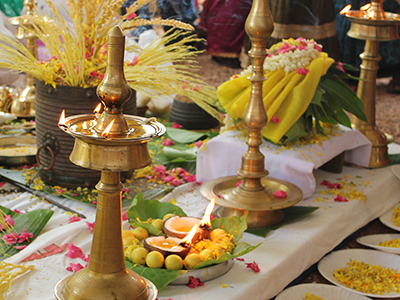
NARRATIVES
THE INVENTION OF FLAVOURS
North India
At Samode Palace, regardless of the formalism de rigueur and chic baroque atmosphere, the waiter genuinely invites the guest to the kitchen as soon as the latter points at the menu with curiosity. When you push the door of the upstairs kitchen, chefs bustle about, play masterfully with the ringing saucepans and move in a coordinated rhythm that allows no faux pas.
Looking at the pictures of delicious dishes hanging on the left wall, I suddenly am indecisive about diving into an unfamiliar playing field. No dish looks like the traditional Rajasthani cuisine offered by most local restaurants. Chefs not only try new combinations of flavours they also look after the presentation of the food with great attention. However, they insist on the label: ‘Here, you will be served creative Indian cuisine and not continental food.’ Appearances can be deceiving, but as soon as the spoon reaches the lips, you know it is Indian flavours.
Because I don’t have the slightest idea of what to order, and because it is my birthday and I am passionate about food, the cooks agree to work on some samples so that I can observe the preparation and try them the next time I cook. They start with the aloe vera fritters. The plant is often used in traditional herbal medicines, against diabetes or high blood pressure, but it is rarely served in restaurants.
One day, for his own lunch one of the sous chefs brought some aloe vera dish cooked by his wife. The chef, who is always eager to add new dishes to the menu, was asked to try it and he immediately loved the idea of cooking aloe vera, so famous for its medicinal properties. He brought the plant to his team and challenged them all to find an original and tasty way to prepare the cactus-like plant. One of them, Sharwan Saini suggested the idea of frying it. Semolina was then added to the flour to make the new appetizer both crispy and golden; then tempura was added for taste.
As I bite in the aloe vera fritter, I am already seduced by the story of its creation and healthy virtues, but soon it is the unusual texture of the translucent vegetable that sparks my curiosity. In many villages on the way, people have pointed at the plant telling me about its incredible properties, but I have never had the opportunity to try it. Here it is served to me by a brilliant chef and his team.


After this first culinary experiment, the chefs prepare some banana flower croquettes. Banana flower, a long and crunchy, dark-pink flower served both raw and cooked in fried croquettes. On the side, lines of mint sauce and red chutney spice things up the Indian way. Finally, the last mysterious dish, evocatively named Mango Kadhi with cottage cheese dumplings, is a traditional North-Indian yoghurt-based gravy served usually with vegetable pakoras, both the sauce and the dumplings using most of the classical Indian spices.
However, they insist on the label: ‘Here, you will be served creative Indian cuisine and not continental food.’ Appearances can be deceiving, but as soon as the spoon reaches the lips, you know it is Indian flavours.
As explained by Mukesh Pandit who oversaw the service: cumin, coriander, garam masala, and red chilli powder are the basics, as well as the garlic-ginger paste, and a touch of lemon almost in everything. To prove his point and show how they also depart from Indian traditions, the team serves me with one last dish, straight out of the tandoor, original in its use of basil: Tulsi Prawns, made with holy Indian basil, cucumber ribbons and sesame seeds. The association of the hot spicy prawns with the fresh crispy cucumber comes out as a simple culinary delight.
Tonight, the main chef is absent, but the sous chefs all tell me about their backgrounds. Only men, most coming from Rajasthan and a few coming from Bengal, so a clear East-Indian influence characterizes some of the dishes. The main chef, who has cooked in famous restaurants of Mumbai and Delhi, creates all the dishes for the fine-dining restaurant upstairs. But twice a week, from July to September, right before the beginning of the new season, the owners ask the whole team to be inventive and come up with new ideas. That is when they let all their imagination run wild. They pick the ingredients of their choosing and start cooking. There begins, the invention of flavours; the revitalisation of Indian cuisine.

In Anticipation of Petrichor
Rain is happiness, rain is melancholy, rain is nostalgia. For Indians, it’s more than just these; it is a part of life...
Narrative

The Charm of Evanescence
Earlier this year, during the summer month of April, Elke Frotscher travelled with us and a crew of photographers to Tamil Nadu...
Narrative • South India

Tracing the Trails of Time
Discover the decadent mansions of Chettinad through the eyes of The New York Times, when they travelled with us exploring architecture...
Behind-The-Scenes • South India

Where Art is Made
This journey explores the many handicraft traditions ranging from pottery to textiles in the states of Rajasthan and Uttar Pradesh...
Bespoke Journey • North India

Samode Haveli
A cherished royal treasure in the walled old city of Jaipur, Samode Haveli is a traditional Indian mansion...
Hotel Guide • North India

Unified by Fire
The thin line between private and public can be almost invisible in India as compared to other places in the world...

